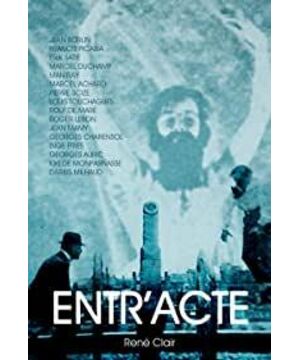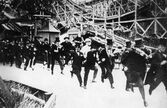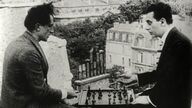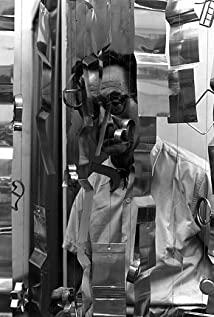"Interlude" was originally an entertaining show prepared for the interlude of the Dada ballet "Performance Pause". The Swedish Rudolf Demarais Ballet, which performed the dance, invited Dada master Picabia to write the script and paint the set. Picabia, incidentally, drew up a two-page first draft for the show. Rainer Clare, who was first involved in the film industry, was deeply influenced by the avant-garde trend of thought, and chose this script to create his second work - "Interlude". Picabia, who drafted the script, said: "The Interlude...is only about the pleasure of life and the pursuit of innovation." However, under Claire's direction, the film permeated the spirit of Dadaism, criticized and ridiculed Bourgeois customs, fashions, culture and etiquette: what good are opera houses and ancient buildings? What is art? A solemn funeral is nothing but a wild chase! The cynicism of the postwar youth generation is clearly visible.
The film challenges the traditional narrative mode, completely abandons the logic of the plot and narrative, and adopts a sloppy and disorderly structure, from the night scene of the theater building to the painter's game scene, from the water column to the rotating dance steps, from the face of a woman to the eyes of jellyfish, From the slowly rising cigarette holder to the ancient Dorian stone pillars... the way the shots are connected is like falling into a fog. Perhaps, this is the "destroyed aesthetics" pursued by Dadaism, but through editing and superimposition, the film highlights the visual image connection between images, such as the lights at night turning into sparkling cigarette butts, and the ballerina's tutu. For a slowly blooming chrysanthemum, the pipes are erected like the pillars of the temple. The peculiar formal beauty of Claire's films has already begun to emerge here.
The "dehumanization" of art advocated by Dada can also be corroborated in the film. Duchamp once advocated "dry art", abandoning any taste and emotional factors. The characters in Rainer Clare's film are allegorical symbols, only elements of abstract expression, without character and will at all. This creative attempt seems to have influenced several of Claire's later works: social and psychological abstraction, stylization of characters and situations, and spiritual idealization are both a feature and a weakness of Claire's films. French theorist Bazin praised Claire's moral judgment but criticized his characters' lack of psychological depth.
However, the distinct rhythm and varied movements of "Interlude" are in line with the nature of the film, fully exploiting the film's advantages, thus compensating for the "dehumanization". In a scene at the funeral, slow motion alternates with normal shots, and slow photography speeds up the chase, making hearses, mourners, trees, roads, houses, and clouds fly by, enhancing the motion of the image. It should be pointed out that Claire did not follow the general concept of avant-garde to use abstract forms when expressing rhythm changes, but used real-life scenes as materials, such as alternately inserting cyclists and car shots, and using a small train in a man-made scenic area to set off running in the scene. A hearse on the mountain road. The chase became Claire's favorite subject, and later films like "We Want Freedom", "Million Francs", and "Italian Straw Hat" all used the breathless chase. People joked that Claire's films belonged to "ballet realism". The rational application of several basic themes of cinematic mise-en-scene is also the product of careful consideration of the screen form. The theme of "chasing" borrowed from earlier films by Claire incorporates the connotation of "justice chasing evil" or "people chasing wealth", thus deepening the film form. The playful parody of the film itself is another implicit feature of the film: the chase scene at the end can be seen as both an homage and a mockery of the films of silent comedy guru Mike Seinart. In order to create the impact of the bizarre visual image, Claire even put the camera on the slide in the park "slide shot", the reflected footage made the audience dizzy.
Dadaist art and the films nurtured by Dadaism provide a "grotesque" perspective to understand the world, and Claire's Dadaist film attempts have also deepened people's sensitivity and understanding of the potential of film. However, Dada's passion is shallow after all, full of blind impulses in the break with tradition. They are unwilling to become spiritual pariahs, but they cannot find their spiritual home and cannot communicate with others. Although the Dadaists in Berlin and Cologne were politically revolutionary, the Dadaist trend eventually became a relic of history.
In 1930, the once avant-garde, Rainer Clare and Jean Renoir, unanimously advocated the abandonment of "obscure artistic exploration" and announced the burial of the avant-garde: "The art of this century is produced with an anti-bourgeois and popular character... Popularity does not equal vulgarity, but means writing for the masses. Art is a kind of communication, and the creator is never writing for a small group of specialists..." "When it comes to genius, don't forget, Griffith , Chaplin and Eisenstein are not created for self-appreciation, nor for a few filmmakers, but for a wide audience around the world."
View more about Entr'acte reviews








